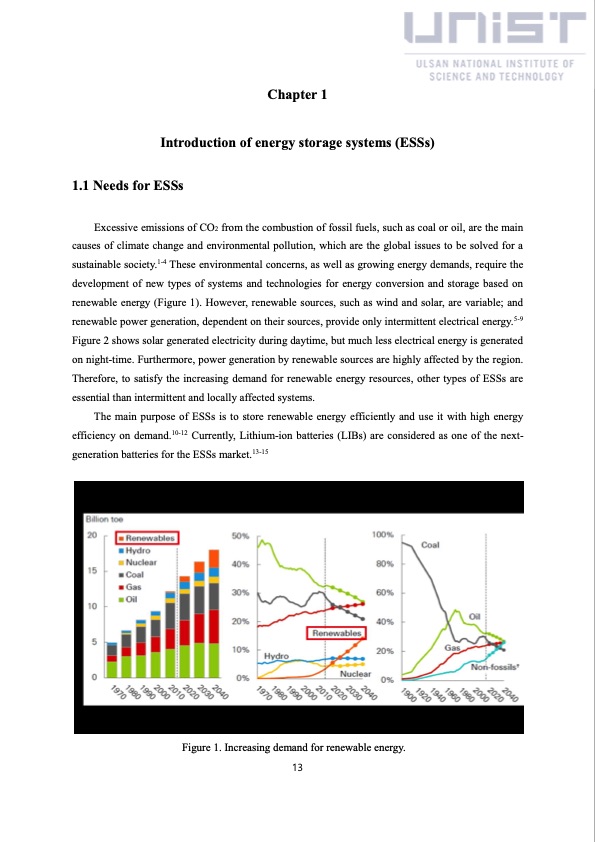
PDF Publication Title:
Text from PDF Page: 018
Chapter 1 Introduction of energy storage systems (ESSs) 1.1 Needs for ESSs Excessive emissions of CO2 from the combustion of fossil fuels, such as coal or oil, are the main causes of climate change and environmental pollution, which are the global issues to be solved for a sustainable society.1-4 These environmental concerns, as well as growing energy demands, require the development of new types of systems and technologies for energy conversion and storage based on renewable energy (Figure 1). However, renewable sources, such as wind and solar, are variable; and renewable power generation, dependent on their sources, provide only intermittent electrical energy.5-9 Figure 2 shows solar generated electricity during daytime, but much less electrical energy is generated on night-time. Furthermore, power generation by renewable sources are highly affected by the region. Therefore, to satisfy the increasing demand for renewable energy resources, other types of ESSs are essential than intermittent and locally affected systems. The main purpose of ESSs is to store renewable energy efficiently and use it with high energy efficiency on demand.10-12 Currently, Lithium-ion batteries (LIBs) are considered as one of the next- generation batteries for the ESSs market.13-15 Figure 1. Increasing demand for renewable energy. 13PDF Image | China solar seawater battery

PDF Search Title:
China solar seawater batteryOriginal File Name Searched:
solar-seawater.pdfDIY PDF Search: Google It | Yahoo | Bing
Product and Development Focus for Salgenx
Redox Flow Battery Technology: With the advent of the new USA tax credits for producing and selling batteries ($35/kW) we are focussing on a simple flow battery using shipping containers as the modular electrolyte storage units with tax credits up to $140,000 per system. Our main focus is on the salt battery. This battery can be used for both thermal and electrical storage applications. We call it the Cogeneration Battery or Cogen Battery. One project is converting salt (brine) based water conditioners to simultaneously produce power. In addition, there are many opportunities to extract Lithium from brine (salt lakes, groundwater, and producer water).Salt water or brine are huge sources for lithium. Most of the worlds lithium is acquired from a brine source. It's even in seawater in a low concentration. Brine is also a byproduct of huge powerplants, which can now use that as an electrolyte and a huge flow battery (which allows storage at the source).We welcome any business and equipment inquiries, as well as licensing our flow battery manufacturing.| CONTACT TEL: 608-238-6001 Email: greg@salgenx.com | RSS | AMP |